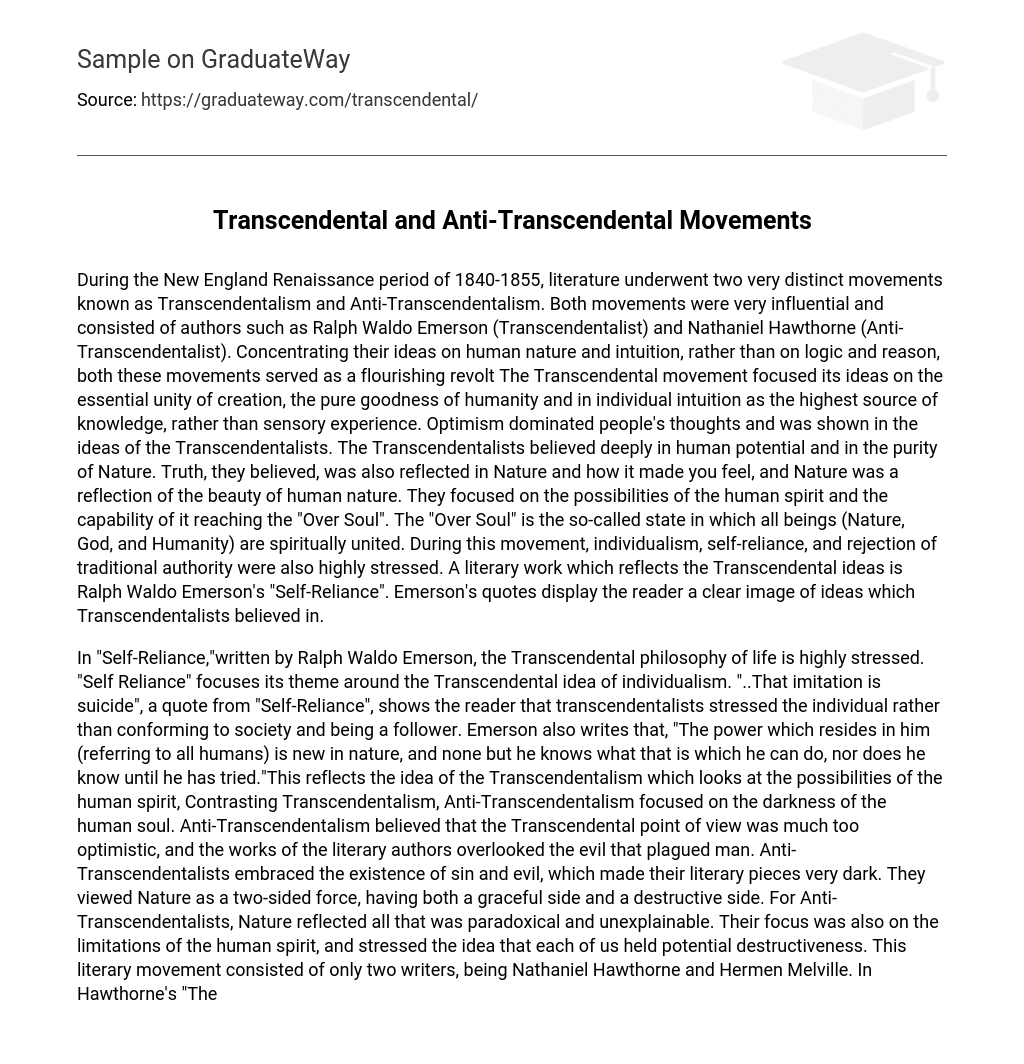During the New England Renaissance period of 1840-1855, literature underwent two very distinct movements known as Transcendentalism and Anti-Transcendentalism. Both movements were very influential and consisted of authors such as Ralph Waldo Emerson (Transcendentalist) and Nathaniel Hawthorne (Anti-Transcendentalist). Concentrating their ideas on human nature and intuition, rather than on logic and reason, both these movements served as a flourishing revolt The Transcendental movement focused its ideas on the essential unity of creation, the pure goodness of humanity and in individual intuition as the highest source of knowledge, rather than sensory experience. Optimism dominated people’s thoughts and was shown in the ideas of the Transcendentalists. The Transcendentalists believed deeply in human potential and in the purity of Nature. Truth, they believed, was also reflected in Nature and how it made you feel, and Nature was a reflection of the beauty of human nature. They focused on the possibilities of the human spirit and the capability of it reaching the “Over Soul”. The “Over Soul” is the so-called state in which all beings (Nature, God, and Humanity) are spiritually united. During this movement, individualism, self-reliance, and rejection of traditional authority were also highly stressed. A literary work which reflects the Transcendental ideas is Ralph Waldo Emerson’s “Self-Reliance”. Emerson’s quotes display the reader a clear image of ideas which Transcendentalists believed in.
In “Self-Reliance,”written by Ralph Waldo Emerson, the Transcendental philosophy of life is highly stressed. “Self Reliance” focuses its theme around the Transcendental idea of individualism. “..That imitation is suicide”, a quote from “Self-Reliance”, shows the reader that transcendentalists stressed the individual rather than conforming to society and being a follower. Emerson also writes that, “The power which resides in him (referring to all humans) is new in nature, and none but he knows what that is which he can do, nor does he know until he has tried.”This reflects the idea of the Transcendentalism which looks at the possibilities of the human spirit, Contrasting Transcendentalism, Anti-Transcendentalism focused on the darkness of the human soul. Anti-Transcendentalism believed that the Transcendental point of view was much too optimistic, and the works of the literary authors overlooked the evil that plagued man. Anti-Transcendentalists embraced the existence of sin and evil, which made their literary pieces very dark. They viewed Nature as a two-sided force, having both a graceful side and a destructive side. For Anti-Transcendentalists, Nature reflected all that was paradoxical and unexplainable. Their focus was also on the limitations of the human spirit, and stressed the idea that each of us held potential destructiveness. This literary movement consisted of only two writers, being Nathaniel Hawthorne and Hermen Melville. In Hawthorne’s “The Minister’s Black Veil,” Anti-transcendental ideas can be recognized throughout the entity of the story.
Nathaniel Hawthorne’s, “The Minister’s Black Veil,” deals with sin and concealed guilt, with hypocrisy and humility, in a dark tale that shows the true insight of the Puritan conscience. His story reflects the Anti-Transcendental ideas, using a black veil covering a minister’s face to symbolize human sin. He symbolized the Anti-Transcendental ideas of life’s truths beings disturbing. “The subject (referring to minister) had bad reference to secret sin, and these sad mysteries which we hide from our nearest and dearest, and would fain conceal from our consciousness, even forgetting that the omniscient can detect them”. This quote from this story, is an example of the Anti-Transcendental idea that we all have sins which we hide, and it is a hypocrisy to hide those sins, because God can still see them. In the following description, it can be noticed that Hawthorne continues to show the fear of sin and also now, the sin of the Earth (Nature). “At that instant, catching a glimpse of his figure in the looking glass, the black veil involved his own spirit in the horror with which overwhelmed all others. His frame shuddered, his lips grew white, he spilled the untasted wine upon the carpet and rushed forth into the darkness. For the Earth, too, had on her Black Veil.” Nature, as believed by the Anti-Transcendentalists, was a symbol of everything unexplainable, and since nobody in the village knew (or wanted to admit) what the black veil symbolized, Mr. Hooper running into nature’s darkness is symbolic of Both the Transcendental and Anti-Transcendental movements, influenced literature greatly. The authors during the movements concentrated on reflecting the ideas (of the corresponding movement) to the reader in a symbolic way through literature. The literature builds the idea of humanity and nature in different perspectives, which reflects the principle ideas of both Bibliography:





